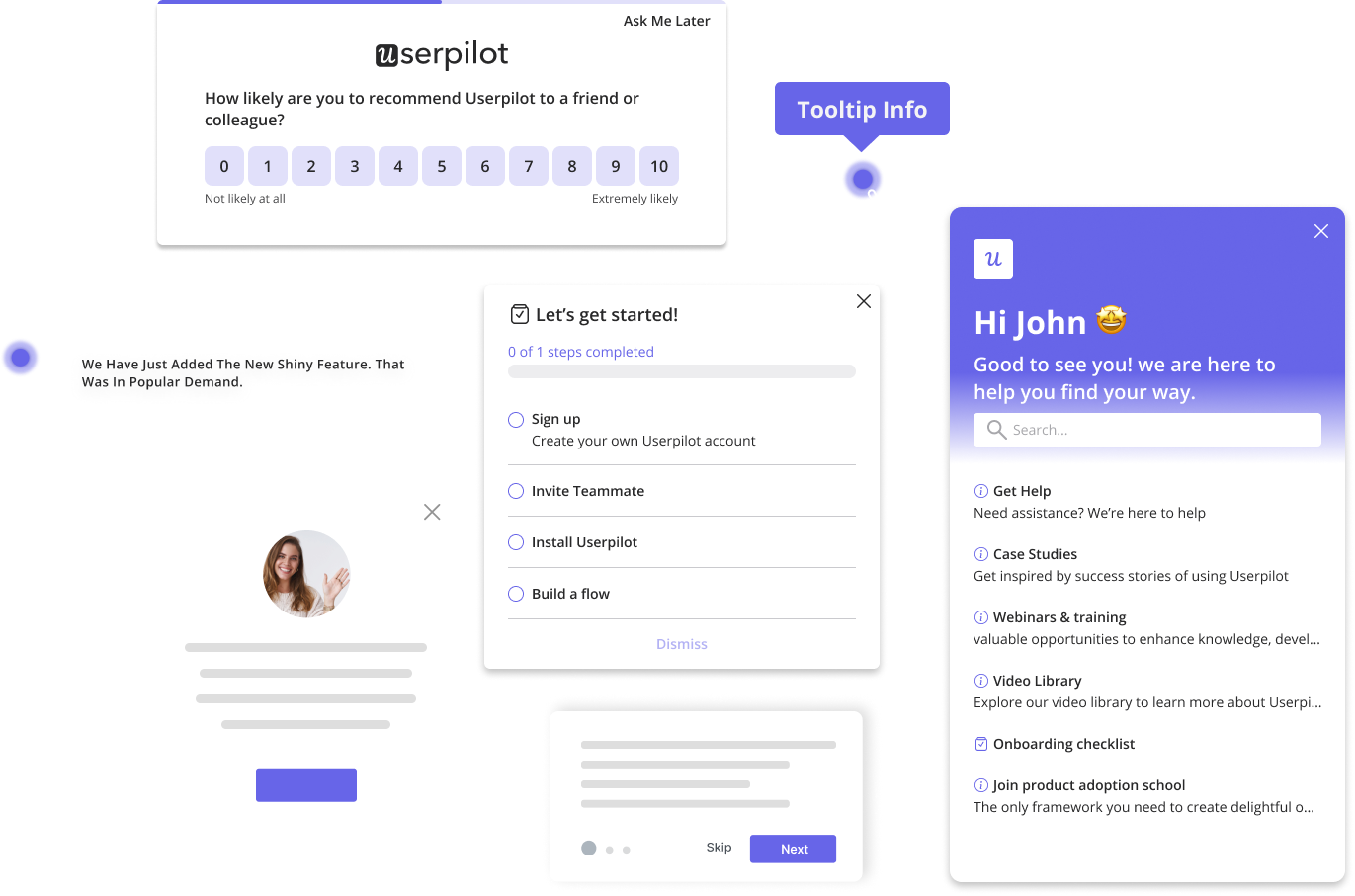
Pendo integrations look broad at first glance. It offers a massive, “app store”-style catalog of 70+ native integrations across CRM (Salesforce, HubSpot), support (Zendesk, Freshdesk), data platforms (Segment, Google Cloud Storage, Amazon S3, Snowflake, Redshift), collaboration (Slack, Confluence), analytics/BI (Looker, Tableau, Domo), developer tools (Figma, InVision), and even guide-specific embeds (Qualtrics, Calendly, UserTesting).
Here’s what they don’t tell us upfront: Pendo’s plans include exactly one built-in integration. Every other connection becomes a paid add-on that requires contacting your account rep for “custom pricing.”
I’ve seen this bait-and-switch approach burn product teams who need multiple integrations for better workflows. You sign up thinking you’re getting comprehensive connectivity, only to discover that linking your essential tools will cost thousands more monthly.
If you’re questioning whether this integration strategy fits your budget and needs, consider switching from Pendo to platforms that don’t treat integrations as opportunities to increase their revenue.
In this review, I’ll walk you through what you’re getting with Pendo integrations and explore when Pendo works versus when it fails.
What’s your biggest challenge with your current setup for Pendo integrations?
How important is it to drive feature adoption with contextual, in-app guidance?
Are you looking for an all-in-one platform that combines analytics, engagement, and user feedback?
You’re ready for a more powerful, flexible, and cost-effective solution.
It looks like your current Pendo integrations aren’t meeting your needs for growth. Userpilot combines powerful product analytics, code-free experience builders, and advanced user feedback tools into one platform to help you drive activation, adoption, and retention.
Try Userpilot Now
See Why 1,000+ Teams Choose Userpilot

Overview of Pendo integrations
Pendo’s integration catalog covers multiple categories, but let me break down what you actually get.
- Analytics and data platforms: Pendo integrates with data warehouses such as Snowflake, Redshift, Amazon S3, and Google Cloud Storage for comprehensive analytics. It also connects with BI tools like Looker, Tableau, and Domo to analyze customer insights. However, there’s no native integration with Mixpanel, Amplitude, or Heap: three popular product analytics software platforms. This forces teams to choose between their existing tech stack and expensive data pipelines.
- CRMs: Salesforce and HubSpot integrations push product usage data and user behavior insights into sales workflows. Marketing teams can create custom segments based on product engagement. However, basic CRM connections beyond your first require additional licensing fees.
- Customer support: Zendesk, Freshdesk, Intercom, and Help Scout integrations connect user behavior to support tickets and feedback collection. You can track customer sentiment and trigger proactive support based on product usage patterns. Knowledge base integrations embed help content and in-app guides, but creating effective tooltips requires significant manual setup.
- Development and project management: Jira, InVision, and Figma integrations connect user feedback to development workflows and roadmaps. Teams must manually act on insights because Pendo doesn’t automate prioritization or suggest next steps.
Does Pendo have an API? Yes, but API access requires higher-tier plans and technical resources.
The primary issue isn’t what Pendo integrates with, but rather its pricing model, which makes each connection expensive.
One G2 reviewer noted, “Pendo is pricey and the add-ons only make it more expensive”.
Another mentioned that “the pricing can be steep for smaller teams or early-stage products.”
Cons and limitations of Pendo integrations
Pendo’s integration model creates operational headaches that force product teams like mine into expensive workarounds or manual processes.
- It can be too expensive (especially as you add connectors): The pricing model penalizes growth and integration needs. In addition to paying for software, you’re also paying per integration, per feature, and per scale milestone, making it difficult for companies to maintain their accounts without breaking budgets.
- Limited analytics integrations: Pendo’s lack of integrations with Mixpanel, Amplitude, and Heap means you must choose between your existing analytics stack or an expensive data migration. As one G2 reviewer summarized: “Third-party integrations are limited.”
- Data inaccuracies undermine decisions: Users consistently report data collection issues that require manual verification for reliable reporting. One G2 reviewer noted that “sometimes, it is taking too long to reflect the data in Pendo dashboards – it is creating confusion whether we have implemented the integration correctly or not.” When your product decisions depend on accurate usage data, these accuracy problems become business-critical failures.
- Integration challenges that create technical debt: Teams struggle with Pendo’s Customer API and integration setup, particularly when trying to connect multiple systems in their tech stack. TrustRadius reviews highlight consistent challenges with system integrations, particularly for teams without dedicated engineering resources. According to this review: “Pendo.io’s Customer API could use quite a bit of improvement, both in terms of what kind of functionality it allows but also in terms of the documentation available for it.”
- Delayed updates kill agility: Real-time decision-making becomes impossible when reports update slowly. Software Advice reviews show consistent delays in data refresh and report updates. One reviewer mentioned “data refresh can be delayed, making it hard to tell if the poll is broken or just delayed.”
When Pendo integrations make sense
Despite these limitations, certain types of organizations can still get value from Pendo’s integration model if they have the right resources and use cases.
Mature product teams
Organizations with established product management processes and dedicated technical resources are best positioned to benefit from Pendo integrations. These types typically have product managers who understand data workflows, engineers who can handle complex API implementations, and clear processes for turning customer insights into action.
We’re talking about teams that already run structured sprint reviews, maintain detailed user personas, and have dedicated resources for tool maintenance. They can absorb the integration complexity because they have someone whose job it is to manage these connections. If you’re a 50+ person product organization with dedicated DevOps support, you can make Pendo’s integrations work despite the overhead.
Data-driven organizations
Companies that already invest heavily in data infrastructure and have data analysts or engineers will find it easier to maintain integration quality and derive actionable insights from connected systems. These organizations typically run their own data warehouses, have established ETL processes, and employ analysts who can work around Pendo’s data accuracy issues.
For example, enterprise teams that already use tools like Snowflake in their tech stack, have dedicated BI analysts, and treat data infrastructure as a competitive advantage. They can build workarounds for Pendo data flows because they have the technical depth to validate data quality and create custom solutions when native integrations fall short. These organizations have the power to optimize their workflows despite Pendo’s limitations.
Complex sales cycles
B2B companies with long sales cycles benefit significantly from Pendo integrations with CRM systems. Product usage data becomes a crucial input for sales qualification and customer success activities when deals take six months or more to close and require extensive proof-of-value demonstrations.
For these companies, connecting product engagement to sales workflows and marketing campaigns can justify the integration costs. Sales teams can use product usage patterns to identify expansion opportunities, customer support can proactively address churn risk, and marketing teams can score leads based on actual app engagement rather than relying solely on demographic data.
When to consider alternatives
Most product teams fall outside Pendo’s sweet spot. If any of these scenarios describe your situation, I recommend considering a Pendo alternative.
Resource-constrained teams
Small product teams without dedicated engineering resources often find integration maintenance to be overwhelming. The ongoing technical debt associated with managing Pendo’s integrations typically outweighs any benefits from analytics.
When you’re a 5-person product team trying to build features and maintain user engagement, spending weeks debugging integration issues isn’t sustainable.
Here’s what it looks like:
- Every connection becomes a maintenance burden.
- Authentication problems halt workflows.
- Data sync issues create confusion.
- API changes break integrations.
Without dedicated DevOps support, your team ends up spending more time managing integrations than analyzing user behavior. The platform becomes a distraction from building product value.
Simple use cases
If your primary need is basic product analytics and user engagement, standalone Pendo functionality may be sufficient without the need for complex integration. Teams focused on simple adoption tracking or basic user onboarding don’t need elaborate data pipelines connecting every tool in their tech stack.
However, even simple needs often fuel growth that quickly outgrows Pendo’s limitations. What starts as basic analytics requirements soon becomes demands for customer insights, user feedback analysis, and cross-platform user behavior tracking. Then, you’ll hit Pendo’s walls faster than expected.
Frequent tool changes
Teams that regularly evaluate and switch software should be cautious about deep integrations. Switching costs become exponentially higher when multiple systems are tightly coupled. If you’re still experimenting with your tech stack or frequently exploring new platforms, Pendo’s integration approach locks you into expensive dependencies.
Need for advanced customer insights
Unlike Pendo’s integration-dependent approach, Userpilot provides advanced customer insights out of the box with autocapture data that eliminates manual tracking setup. Our platform automatically collects user behavior data, analyzes user feedback patterns, and provides customer insights without requiring expensive integrations.
Userpilot’s built-in analytics provide a complete view of user journeys, enable you to segment users based on actual app usage, and track adoption metrics that inform product decisions.
You get session replays, user feedback collection, and behavioral analytics in one platform. In other words, you can optimize user experience, improve retention, and drive feature adoption without technical overhead.
More cost-effective solutions
While Pendo charges thousands for basic integrations, Userpilot includes comprehensive product analytics, user feedback tools, and engagement features in our base plans. You get more functionality for less money, with pricing that scales reasonably as your user base grows.
Our transparent pricing means no surprise integration fees, no per-connector charges, and no mandatory account rep negotiations. You can access advanced product analytics, create in-app guides, collect user feedback, and segment customers without breaking budgets.
Making the decision
Before implementing Pendo integrations, ask yourself these critical questions:
- What specific business problems are you trying to solve? Generic “better data visibility” isn’t a sufficient justification. Identify concrete use cases where integrated data would change decision-making or workflows.
- Do you have the technical resources for ongoing maintenance? Integrations aren’t set-and-forget solutions. They require monitoring, updates, and occasional troubleshooting that drain product teams from building features users actually want. Without dedicated support, you’ll spend more time fixing connections than analyzing user behavior.
- How will you measure success? Establish clear metrics for integration value, whether that’s reduced time-to-resolution for support tickets, improved lead qualification accuracy, or faster product iteration cycles.
- What’s your data governance strategy? Multiple integrated systems mean various sources of truth. You’ll need clear data ownership and quality standards before connecting systems: complexity that Userpilot’s unified platform eliminates.
Our platform offers a simpler setup, reliable features, and pricing that won’t increase sporadically. Book a demo to see how Userpilot automates what Pendo makes complicated, without the integration headaches.






